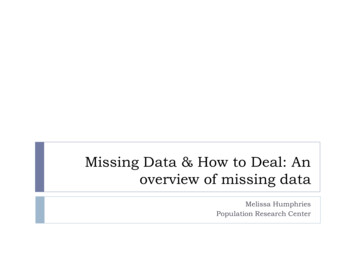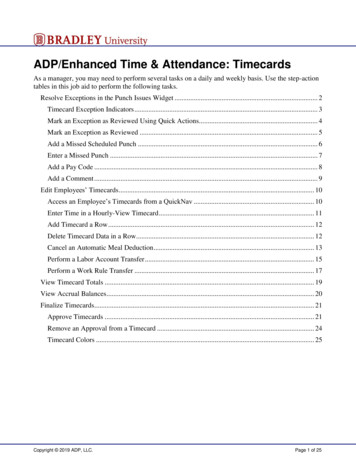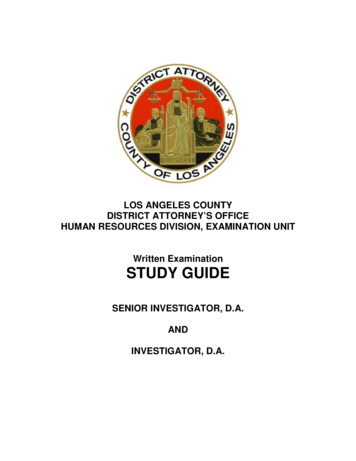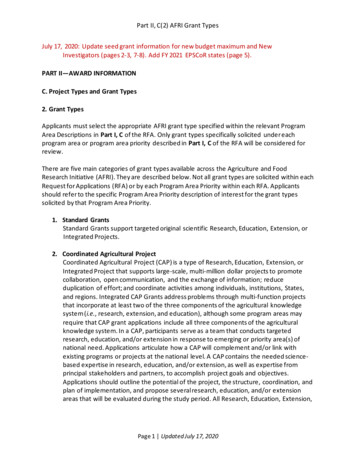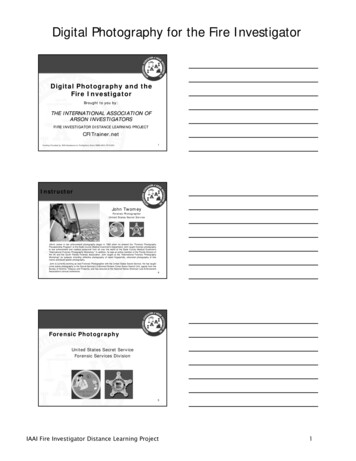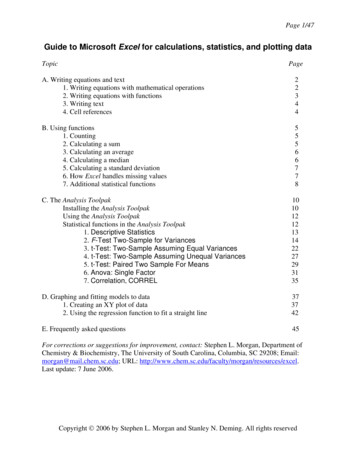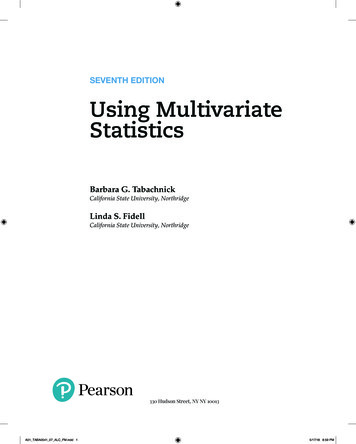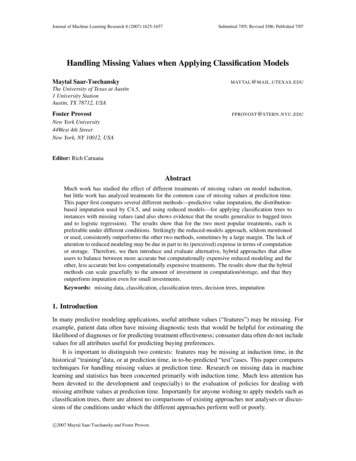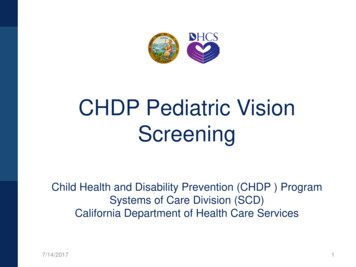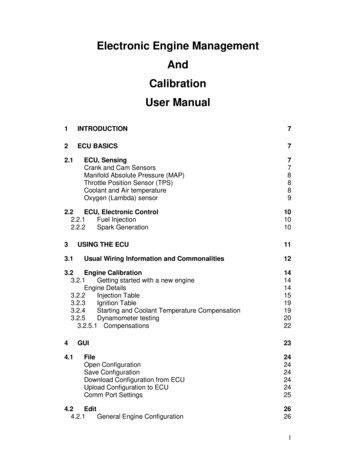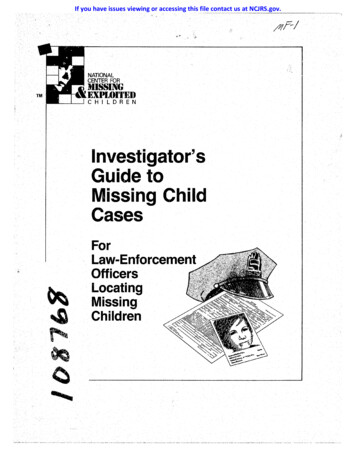
Transcription
If you have issues viewing or accessing this file contact us at NCJRS.gov.""NATIONAL, CENTER FOR)11s. IN(.I XI)IA)JrrIU)---'-----' CHI L D R E NInvestigator'sGuide toMissing ChildCasesFor. Law-EnforcementOfficersLocatingMissingChildren,
Investigator's Guide toMissing Child CasesForlaw. . Enforcement Officerslocating Missi,ng ChildrenOctober 1987Second EditionJohn C. Patterson108768U.S. Department of JusticeNational Institute of JusticeNCJ This document'has been reproduced exactly .as recei e? from theperson or organization originating it. Points of view or opInions stat?din this document are those of the authors and do. not nec ssanlyrepresent the official position or policies of the National Institute ofJustice.Permission to reproduce this y .igMeci-material has beengranted byPublic Domain/OJJDP lu. S. Departmentof Justiceto the National Criminal Justice Reference Service (NCJRS).Further reproduction outside of the NCJRS system requires permission of the owner. National Center for Missing & Exploited Children
AcknowledgmentsThe National Center for Missing and Exploited Children is indebted to thefollowing individuals-without whose knowledge and expertise this publication would not have been possible:Detective Gary O'ConnorLower Gwynedd Township PoliceDepartmentLower Gwynedd Township,PennsylvaniaLt. William SpauldingLouisville Police DepartmentLouisville, KentuckyJames ScuttDirector, Victim AssistanceProgTamNational Sheriffs' AssociationDetective Frank FeichtingerAnchorage Police DepartmentAnchorage, AlaskaProfessor J. Kerry RiceKent School of Social WorkLouisville, KentuckyRichard RuffinoExecutive DirectorNew Jersey Commission onMissing PersonsTECHNICAL ADVICE PROVIDED BY:Kenneth V. Lanning, SSABehavioral Science Unit, Training Division, FBI AcademyQuantico, VirginiaDavid F. Nemecek, Section ChiefNCIC, Technical Services DiVIsion, FBI-HQWashington, D.C.CONTRIBUTING STAFF FROM THE NATIONAL CENTER FORMISSING AND EXPLOITED CHILDREN, ORIGINALLY FROMLAW-ENFORCEMENT AGENCIES AROUND THE COUNTRY:John Rabun, Deputy Director (Louisville, Kentucky)Jeanne Dillon, Supervising Technical Advisor (Miami, Florida)Charles Pickett, Technical Advisor (Richmond, Virginia)Scott Mandell, Technical Advisor (Nueces County, Texas)Margarete Sanders, Technical Advisor (Louisville, Kentucky)Janet Kosid, Director of Legal Technical Assistance (Solano County, California)Prepared under Cooperative Agreement #86-MC-CX-K003/4 from the Office ofJuvenile ,JuStice and Delinquency Prevention, Office of Justice Assistance, Research,and Statistics, U. S. Department of Justice.Points of view or opinions in this pUblication are those of the NCMEC and do notnecessarily represent the official position or policies of the U. S. Department ofJustice.
U.S. Department of JusticeOffice of Juvenile Justice andDelinquency PreventionWashington. D.C. 20531Dear Reader:In recent years, the law enforcement profession has made muchprogress in imp:toving training and setting performancestandards. However, missing children investigations is an areathat has been somewhat neglected and underdeveloped.To helpaddress this problem, the National center for Missing andExploited Children, in cooperative agreement with the Office ofJuvenile Justice and Delinquency Prevention (OJJDP) at the U.S.Department of Justice, developed an Investigator's Guide toMissing Child Cases.It provides guidance to law enforcement of"ficers investigatingparental kidnappings, abductions by strangers, runaway or"throwaway" cases, and those in which the circumstances areunknown. The guide describes, step-by-step, the investigativeprocess required for each of the four types of missing childcases.The guide also includes instructions on how to put informationabout missing children into the National Crime InformationCenter's computerized system. In addition, the booklet offerssuggestions for forming police-social worker teams to work onmissing and exploited children cases.The issue of missing and exploited children is a tragic butrealistic one that we must deal with. This guide is an importanttool for helping law enforcement officers who investigate suchcases.Ver. AdministratorOffice of Juvenile Justice andDelinquency Prevention
A Message to the ReaderThis is the second edition of the Investigator's Guide to Missing Child Cases. Wehave made changes in its organization to reflect the investigative path for eachkind of missing child case. Other changes have been made based on feedbackreceived from law-enforcement users of the first edition.Readers of this edition will recognize the National Center's continuingcommitment to the principle that "No missing child case is closed until the childis located or a body is recovered and identified."Recognizing that resource limitations may make it difficult to duplicate theapproaches taken in this manual, the National Center for Missing and ExploitedChildren encourages law-enforcement agencies to adopt as many of the recommendations as possible.In addition, although local law and procedures may limit the authority ofindividual jurisdictions to implement the recommendations in this guide, acreative approach to other sources of authority may provide the officer with morejurisdiction than is traditionally thought to be available. For example, a lawenforcement officer may find that child labor laws, liquor control laws, anddependency and neglect laws can be the basis for action in a case involving a childwho is voluntarily missing.Further, the reader may note that the National Center refers to the class ofmissing child cases commonly known as "stranger abductions" as "nonfamilyabductions." The purpose of this change in terminology is not to be creative but,rather, to avoid reinforcing the common misconceptions surrounding the notion of"stranger danger." It is not enough to warn a child not to accept candy from a"stranger:' Research has demonstrated that abuse is far more likely to occur at thehands of an acquaintance or a family member. In addition, abductions byunknown individuals are frequently committed by someone who has befriendedthe child-even for a few minutes-and is therefore not a "stranger" to the child,even though he or she may be unknown to the parents.
ContentsIntroduction viiNational Center for Missing and Exploited ChildrenState Clearinghouses ixNonprofit Organizations ixVIll1. Phase One: Initial Response 1Unusual Circumstances 1Steps in the Initial Response 2Crime Analysis Unit 4Summary: Initial Response 4Initial Response Investigation Checklist 52. Voluntary Missing Cases 7Intensive Investigation 7Sustained Investigation 9Follow-up and Close-out 10Summary: Voluntary Missing Cases 10Voluntary Missing Case Investigation Checklist 113. Parental Kidnapping Cases 13Intensive Investigation 13Sustained Investigation 17Follow-up and Close-out 18Parental Kidnapping Case Investigation Checklist 194. N onfamily Abductions 21Intensive Investigation 21Sustained Investigation 27Follow-up and Close-out 27Nonfamily Abduction Case Investigation Checklist 27Unknown Missing Cases 285. National Crime Information Center (NCIC) 31Missing Persons File 31Unidentified Persons File 32Other NCIC System Files 33Summary: NCrC System 33Case History 33v
---------- --6. Police/Social Worker Teams 35Organization and Structure 35Procedures 36Social Worker Functions 38Summary: Police/Social Worker Teams 38Appendix1. Missing Child Poster Format 392. NCrC Missing Person Report Form 403. NClC Unidentified Person Report Form 414. Exploited/Missing Child Task Force Form 425. Federal Parent Locator Service Authorization Form 43State Clearinghouse List (inside back cover)vi--------
IntroductionThe purpose of this publication is to provide guidance to law-enforcement officersin conducting missing child investigations. Included are the recommended stepsfor each phase of the im:estigative process for each kind of missing childinvestigation:Voluntary Missing This category includes those children and youths whohave run away from home, as well as "throwaways"-children who havebeen rejected or abandoned by their families and are homeless.Parental Kidnappings These are cases in which a parent or relative hasillegally taken, kept, or concealed the missing child from another parent orlegal custodian.Abductions by Unknown Individuals or Nonfamily Members Commonlyreferred to as "siranger abductions," these are cases in which the child wastaken, kept, or concealed by a person other than his or her parent or legalcustodian.Unknown Missing These are cases in which the child is missing and thefacts of the case are insufficient to determine if the child was abducted, wasthe victim of an accident, or voluntarily left home.The rationale for law-enforcement intervention is simple:Louisville, Kentucky,data on exploitedMissing child cases often involve a violation of the law and alwaysinvolve the need to provide protection for the child. Even thoseyouths who voluntarily leave home run the risk pf becominginvolved in criminal activity or exploitation through. involvementin prostitution, child pornography, or with pedophile "protectors." Studies show that 85 percent of exploited children aremissing when exploitation occurs.child cases, 1981-1983Each kind of missing child case requires appropriate investigative strategiesduring each of the four phases of case investigation:Initial Response Regardless of the kind of missing child case, the initialresponse requires a preliminary investigation to determine the facts of thecase and the structure of the subsequent investigation.Intensive Investigation This stage begins once it has been determined thata child is missing and continues until initial lead information is exhaustedand further leads have not yet developed.Sustained Investigation The third phase consists of developing leads afterthe trail grows cold and following whatever leads are generated.Follow-up and Close-out Upon location of the child or recovery and identification of the child's remains, the final stage includes steps necessary tovii
---detennine what crimes may have been committed before or during the timethe child was missing; it also includes routine steps to close out case files anddelete NCrC entries.Law-enforcement agencies should not feel that they alone can meet all thedemands of a missing child investigation. Other sources of help are availablethat can relieve the burden of the case investigation and provide assistance tothe families. These sources include the National Center for Missing andExploited Children, state clearinghouses, and nonprofit missing children'sorganizations.National Center for Missing and Exploited ChildrenThe National Center for Missing and Exploited Children, through its TechnicalAdvisory staff, provides technical assistance to law-enforcement agencies handling missing child cases. Technical assistance may include arranging for mediadisplay of a missing child's photograph, forwarding lead information obtainedfrom the National Hotline for Missing Children (toll-free: 1-800-843-5678), orproviding on-site case review at the request ofthe investigating law-enforcementagency.In each kind of missing child case, the investigator should call theNational Center's toll-free National Hotline and discuss the case with one ofthe technical advisors. Each National Center technical advisor is a formerlaw-enforcement officer with expertise and field experience with missing childinvestigations.The purpose of the National Hotline is to take information on sightings ofmissing children. The Center can arrange for the nationwide (and into Canada)toll-free number-1-800-843-5678-to be used for sighting information and caninclude the case in the national missing children's media programs. The 800operators use a protocol developed by the technical advisors, consisting.of aboutsixty specific questions that are computer supported.All leads are reviewed by technical advisors and forwarded immediately tothe law-enforcement agency on record (ORI) in NCrC and the FBI, if involved,by first-class mail, NLETS, or express service. It is important to note that thelead information obtained by the National Center is shared only with the lawenforcement agencies having responsibility for the case investigation. TheNational Center does NOT provide the information to the parents, privateinvestigators, or the media. The National Center believes that it is importantfor the ORr to control access to the information. All requests for specificinformation concerning leads will be referred to the ORI and FBI.To arrange for technical assistance, simply call the National Center's toll-freenumber, 1-800-843-5678, and ask for a technical advisor.viii--,
State ClearinghousesIn many states, another avenue for support of missing child cases is available tolaw-enforcement-state clearinghouses for missing children. These are stateagencies, often part of the state police, that were created to assist \vith missingchild cases. Services vary from state to state, ranging from maintenance of acentral registry for missing child cases to comprehensive investigative capability.Make contact with your state clearinghollse to determine its ability to supportmissing child case investigations before you need the services. In this manner, youcan incorporate the clearinghouse's support, limited though it may be, in yourresponse planning and policies and procedures. Out-of-state clearinghouses areusually very helpful in making arrangements for the return of a missing childfrom their jurisdiction. Note: A list of state clearinghouses is included on the backinside cover.Nonprofit OrganizationsNonprofit missing children's organizations provide another source of support towhich law-enforcement agencies may refer families of missing children. Theseorganizations will assist families with poster distribution, provide peer counseling, and assist in many other areas. Most state clearinghouses have referrallistings of nonprofit organizations, as does the National Center for Missing andExploited Children.Many of the nonprofit organizations have established a good relationshipwith the law-enforcement agencies in their communities. When dealing with anew or unknown nonprofit organization, it is important to familiarize yourselfwith the services provided and the background of the principals within theorganization. Unfortunately, with the heightened public awareness concerningmissing children, a number of well-intentioned individuals have become misdirected in their zeal to help children. Even worse are those who seek to exploit theissue of missing children for their own unethical gains.be
1. Phase One:I litialResponseA missing child case should be viewed as a pot{ ntial crime against a person andtherefore requires a preliminary investigation tv Eon out the facts of the case andto structure the remainder of the investigatiM:. A patrol officer should bedispatched promptly to take the initial report and to conduct the preliminaryinvestigation. This is not only good police practice but has become a requirementof many state laws. When assigning the call, the dispatcher should give theresponding officer the missing child's name and a description of the child'sphysical appearance and clothing; such information may enable the officer tolocate the child en route.There are several reasons why pat.rol officers should be involved in a missingchild investigation. The uniformed patrol officer is the one person most likely tobe available on a twenty-four-hour, seven-day-a-week basis and is the one likdyto be familiar with the neighborhood. The following procedures require that thepatrol officer make direct contact with the parents-not only because the parentsneed assistance at this time but also because valuable information needs to becollected for investigative purposes.Dispatch a patrolofficer to take themissing child report.Unusual CircumstancesIf, during the preliminary investigation, the patrol officer determines or suspectsthat any of the following unusual circumstances exists, the police agency must beprepared to mobilize its available resources and take immediate action.1. The missing youth is thirteen years of age or younger.This age is established in the federal Missing Children's Assistance Actbecause children of this age group have not established independence fromparental control and do not have the survival skills necessary to protectthemselves from exploitation on the streets.2. The missing youth Is believed to be out of the zone of safety for hisor her age and developmental stage.The zone of safety will vary depending on the age of the child and his orher developmental stage. For an infant, {he zone of safety will be theimmediate presence of an adult custodian or the crib, stroller, or babycaniage in which the infant was placed. For a school-age child, the zone ofsafety might be the immediate neighborhood or the route between homeand school.3. The missing youth is mentally incapacitated.If the child is developmentally disabled or emotionally disturbed, he or shemay have difficulty communicating with others about needs, identity, oraddress. The nature of the disability places this child in extreme danger ofexploitation.1Immediate action isnecessary underunusualcircumstances.
-----.------------------------------------ -----------The first'consideration is toprotect the child.4. The missing youth is drug dependent (including prescribed medication or "user's habit").Any dependency, whether on drugs, prescription medicines, such asinsulin for diabetes patients, or addictive narcotics, puts the missing childin an "at risk" category. Without regular medication, the diabetic orepileptic child's condition may become critical (life threatening), resultingin a coma or seizures. The drug abuser, on the other hand, may resort tocrime or become the victim of exploitation in order to satisfy his or herhabit.5. The missing youth is a potential victim of foul play, sexual exploitation, or is in a dangerous environment.Whenever a youth is mi.ssing and there are indications of possibleabduction, violence at the scene of the abduction, or signs that indicatepossible sexual abuse, the child is endangered-and immediate mobilization of the police department is essential. In any dangerous environment,an immediate response is called for. "Dangerous environment" is arelative term that depends on the age and development of the child-itcould be a busy highway for a toddler; it could be an all-night truck stopfor a teenager.6. The missing youth has been absent from home for more thantwenty-four hours before being reported to the police.A parent's failure to report a missing child for twenty-four hours may bea sign of neglect or possible abuse in the family. Also, in some cases,parents may wait to contact the police because they have been told thatthe police department will not act on a missing child case bcfore the childhas been gone more than twenty-four hours. Unfortunately, this allowstime to pass that could be crucial in recovering the child. If this occurs, thepolice department should take immediate action to compensate for losttime.7. The missing youth is believed to be with adults who could endangerthe welfare of the minor.Whenever there is an indication that the child may be with an adult whocould exploit or otherwise place the child at risk, immediate interventionis essential. Such cases include youths with a history of running away andwho have developed relationships with pimps, "chickenhawks," or drugpushers. A missing child is not simply in danger of potential sexualexploitation but may also become involved in criminal activity, such asburglary, shoplifting, or robbery.8. The absence is a significant deviation from established patterns ofbehavior that cannot be explained.Most children have an established routine that is, within reasonablebounds, predictable. A major deviation from that routine is cause forconcern. This is not to say that an All Points Bulletin should be issuedwhenever a child is a few minutes late from school; a child missing forseveral hours, however, should trigger a response from the investigatingagency.IAny of the above criteria in a missing child case should signal the need forimmediate action to minimize the danger to the child and promote a timelyrecovery. Such action will vary from department to department and from case tocase. The following sections discuss the investigative steps for the initial response.Steps in the Initial ResponseInterview Parents Upon arriving at the scene, the patrol officer should interview both ofthe child's parents (separately, if possible) and try to determine if the2
child has been abducted by a stranger or the other parent or has left homevoluntarily. The officer should always determine the legal custody status of thechild. The officer should ask the parents who saw the child last and should obtaina list of the child's friends-with addresses. Great care should be taken to ensurethe correct spelling of the missing child's full name and any nicknames (AKAs),the exact date of birth, sex, and race. This information is vital for entry, then laterquery, into the National Crime Information Center Missing Persons File (NCICMPF). Parents should immediately report a child's disappearance; if they havenot, the officer should find out why.Make sure that theinformation iscomplete andaccurate.Note Everyone Present at the Scene The first officer arriving at the scene or atthe cpild's home should write down the names of everyone present, as well asthose who are searching. Identities should be verified using driver's licenses orother photo identification. These people may provide leads to the identity of theabductor if later investigation determines that an abduction took place. As inarson cases, the abductor often will return to volunteer to assist in the search inorder to monitor the progress being made on the case.Physical DescriptionJPhoto A complete description of the child should beobtained from the parents, including the clothing the child was wearing and anyhandicaps, scars, or other identifying characteristics, such as braces on the teethor pierced ears. This information should be broadcast in a "Be on the Lookout"Bulletin. The broadcast should explain what action is requested if the child isfound, such as "locate and detain;' "check safety and welfare," etc.In addition, the patrol officer should obtain several recent photographs of thechild and find out from the parents if the child had been fingerprinted and ifdental charts and medical records are available for possible future use. If the childis believed to be in the company of another person, the police should obtain adescription of that person and of the possible vehicle used.Search the Home The patrol officer responding to a missing child report shouldrequest permission to search the home. It is not unusual to find a missing child athome, even after the parents have conducted a search before calling the police. Infact, a later search by a second officer may be useful. The searches should bethorough, including closets, piles of clothes, under beds, in crawl spaces, attics,and other storage spaces, in large boxes, in old refrigerators-in short, anywherea child could crawl into or hide and possibly be asleep or not be able to get out.While conducting the search, the officer should be alert for other clues that mayindicate foul play or possible reasons for the child's disappearance.Talk with Family Members Other family members living in the home mayprovide valuable insight into the circumstances sUlTounding a missing child case.If possible, interview other family members individually and away from theparents.Brothers and sisters may know of friends unknown to the parents. Otherfamily members should be asked if the child spoke of running away or of suicide;they may also know the last time the child was seen. Siblings may be able toindicate the presence of physical or sexual abuse within the family. Caution: Inexploring the possibility of abuse with other members of the family, the officershould be as tactful as possible. The officer taking the report should be inquisitive,yet professional and sensitive. Some interviews may have to be done privately inorder to obtain true information. During the interviews with the parents and withother family members, the officer must not impart false hopes or fears.File Report with NCIC Assuming that the child was not recovered during theinvestigation related to the initial response, the inyestigating agency shouldimmediately file a report with the National Crime Information Center (NOIC).This report should be filed in all missing child cases upon confirmation of amissing child. All missing children, including runaways, can and should be3Search areas where achild of that agemight be able to go.
entered in the NCIC system without any waiting period. It is not necessary forcustody to be determined before entering the child into the NCrC Missing PersonsFile. Providing the parents with a copy of the NCrc printout may be reassuringto them, and it will give them an opportunity to verify the accuracy of theinformation entered into the NCrC system.Many policc: departments historically have had policies establishing a waiting period. Such policies should be abolished because they may increase policeliability, greatly diminish the effectiveness of the system, and hinder the abilityof other departments to identify and return the child to the family. Reproductionsof the NCrC Missing Persons File form and the Nerc Unidentified Persons Fileform are found in Appendix 2 and Appendix 3, pages 40-41.Develop a Case File All information developed as part of the preliminaryinvestigation and also supplemental information should be placed in the mastercase file. This file should include the missing persons report taken by the patrolofficer dispatched to the home or to the scene of the abduction; pictures of thechild, or a memorandum indicating that none were available; a hard copy of theNClC entry into the Missing Persons File; and supplemental reports withstatements of witnesses, family, and friends. It is critical to the management of amissing child case to have this information in a central repository. As additionalinformation is gathered, the master file should be updated. A copy of the NCrCprintout should be placed in the file whenever supplemental information isentered into NCrC.Crime Analysis UnitCrime analysis canhelp build the case.The crime analysis unit should be involved in preparing case review informationon the missing child to determine if the youth has been identified on Fieldrnterview (FI) cards with other youths or adults or has been involved with drugsor activities that could produce information sources.The crime analysis unit should also help search for previous missing youthpatterns in the area where the youth lived or was seen last. A person-patternanalysis should be made between the missing youth and known offenders in thearea to find any cross patterns that develop investigative focus or provide clues forinvestigative activity.The unit should establish a tip file to organize possible leads and to preventduplication of investigation by different shift investigators.In addition, the crime analysis unit should provide case enhancementinformation, including a victim file, school incidents file, field interrogationsinformation, a suspicious vehicle file, and suspicious persons file. The crimeanalysis unit should act as the focal point of information exchange relevant to themissing child case.Summary: Initial ResponseInformation capturedinitially is vital tolater strategy.The initial response to the report of a missing child should be to dispatch an officerto the child's home or to the scene of the disappearance. The purpose of thepreliminary investigation is to sort out the facts of the case as they are known andto use them to structure the rest of the investigation. The investigating officershould look for any unusual circumstances warranting an immediate, intensiveresponse to protect the child. Upon arriving at the scene, the officer shouldinterview the parents and obtain a description to be broadcast as a "Be on theLookout" Bulletin. In addition, the officer should obtain a recent photograph ofthe missing child, interview other family members, and search the child's home.If these steps do not recover the child, a report of the missing child shouldimmediately be entered into the NOrc Missing Persons File and a master case fileestablished.4
Once the police have received the initial report and have determined that thechild is missing, the case enters the next phases. During these phases, theresponsibility for the ongoing investigation is assigned to another investigator orto the officer who made the initial report. Every missing child case requires thata law-enforcement officer be assigned to lead the investigation, coordinate thesearch, follow up on leads as they come in, and be held accountable for the activeinvestigation of the case. The processes used are outlined in the followingchapters and will differ depending on the kind of missing child case beinginvestigated.Initial ResponseInve :ttigationChecklisto Take initial description.NameClothing wornPhysical appearanceo Dispatch patrol officer.o Broadcast description.o Interview parents.What is the correct spelling of the child's name?What is the correct date of birth?What nicknames does the child have?Who has custody?Who saw the child last?Where was the child last seen?When was the child noticed to be missing?Who are the child's friends and their addresses?Verify physical description provided in broadcast.Are there any unusual circumstances?o Note everyone present at the scene.Name?Photo identification?o Search the home.ooGet permission from the parents to search the home.Look in any place a child might be able to crawl into or hid
Department of Justice, developed an Investigator's Guide to Missing Child Cases. It provides guidance to law enforcement of"ficers investigating parental kidnappings, abductions by strangers, runaway or "throwaway" cases, and those in which the circumstances are unknown. The
